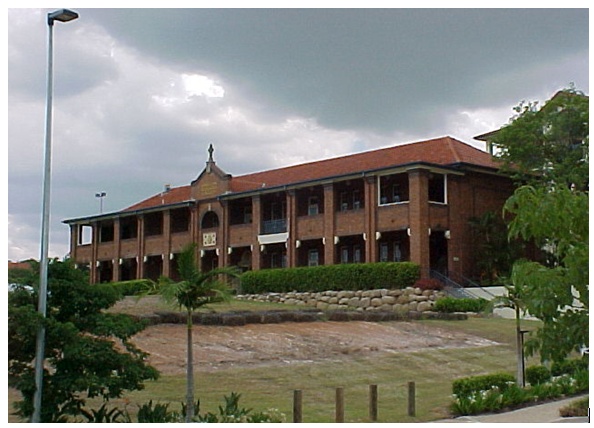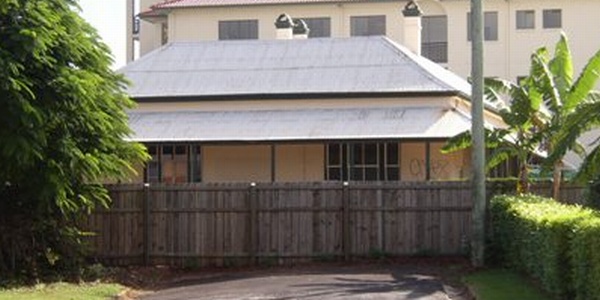Addresses
Type of place
School, House, College
Period
Victorian 1860-1890, Interwar 1919-1939
Style
Free Classical, Free Style, Regency
Addresses
Type of place
School, House, College
Period
Victorian 1860-1890, Interwar 1919-1939
Style
Free Classical, Free Style, Regency
This site comprises three buildings of heritage significance. Highlands is one of the earliest surviving residences in the Albion area. It was constructed in 1869 for Benjamin Brookes and was incorporated into the Christian Brothers College in 1926. O’Driscoll Hall was the first purpose-built school structures for the Christian Brothers St Columban’s College, opened in 1928. Whytecliffe was constructed in 1876 and was designed by prominent Architect F.D.G. Stanley as an elite private residence for Queensland's Crown Solicitor Robert Little. It too was eventually incorporated into the Christian Brothers College, being purchased in 1959.
Lot plan
L20_SP134912
Key dates
Local Heritage Place Since —
Date of Citation —
Construction
Walls: Face brickPeople/associations
Francis Drummond Greville Stanley - Whytecliffe House (Architect);Hennessy, Hennessy and Co. - O'Driscoll Hall College (Architect)
Criterion for listing
(A) Historical; (A) Historical; (A) Historical; (B) Rarity; (B) Rarity; (E) Aesthetic; (G) Social; (H) Historical associationInteractive mapping
Lot plan
L20_SP134912
Key dates
Local Heritage Place Since —
Date of Citation —
Construction
Walls: Face brickPeople/associations
Francis Drummond Greville Stanley - Whytecliffe House (Architect);Hennessy, Hennessy and Co. - O'Driscoll Hall College (Architect)
Criterion for listing
(A) Historical; (A) Historical; (A) Historical; (B) Rarity; (B) Rarity; (E) Aesthetic; (G) Social; (H) Historical associationInteractive mapping
History
O’Driscoll Hall
During the 1920s the demand for educational services rose markedly across the northern suburbs, stretching the capacity of the existing schools; both state and church-run. On 5 December 1927 Archbishop James Duhig blessed and laid the foundation stone of the Christian Brothers St Columban’s College. The prominent Brisbane architectural firm Hennessy & Hennessy which undertook a number of commissions for the Catholic Church during the 1920s and 1930s designed the building. In addition to their church work, the firm was responsible for the design of a number of other large commissions such as Newspaper House in Queen Street Brisbane, and the University of Queensland’s Forgan Smith Building.
The Apostolic Delegate Rev. B. Cattaneo officially opened the College on 29 January 1928 at a ceremony attended by around 600 people. The staff of the college comprised four Brothers, including the Principal and Superior of the Monastery Brother Francis Pius O’Driscoll. At the age of thirty Brother O’Driscoll had already founded and managed one school in Melbourne – he eventually established a total of six schools during his lifetime. This first classroom block was later renamed O’Driscoll Hall in honour of the founding Principal. Around two hundred students were expected to be taught by the four Brothers, although the first-day enrolment was 128 boys, paying fees of between £3/10/- and £6 a term.
Archbishop Duhig had already purchased Highlands for the Brothers’ residence – this and O’Driscoll Hall formed the basis of the new school, set on a large and commanding site.
Enrolments grew quickly, and new school facilities were constructed. These included the Memorial Library built by the Old Boys’ Association to commemorate their companions killed during the Second World War, the Duhig Hall science block opened in 1962, and the John Parry classroom and science block opened circa 1965. The school gradually acquired more land, beginning with the houses which originally stood between the original school building and Sandgate Road. By the late 1950s the school owned virtually all the land from O’Driscoll Hall to Sandgate Road. Archbishop Duhig added further to the holding in 1959 when he purchased Whytecliffe for use by the school.
Highlands
Early in 1868 Brisbane man Benjamin Brookes bought almost nine acres here, and according to most sources, built his house the following year. Benjamin was a brother of the founder of the ironmongery firm William Brookes & Co. It is likely that Brookes designed the house. A Benjamin Brookes, ironmonger and amateur architect also designed a chapel for the Baptist Church in Vulture Street South Brisbane during the early 1870s.
Business James Berkley bought Highlands in 1871, subsequently selling to the Hon. William Graham in 1879. Scottish-born Graham managed Jondaryan Run for Kent and Weinholt from 1861 until 1870, after which he purchased several runs in the Dalby and Tambo districts, in addition to at least one grazing property in north Queensland. He represented the Darling Downs in the Legislative Assembly from 1875 until 1878, and sat in the upper house from 1880 until 1892.
It was Graham who extended the modest four-room house into a large and rambling home with some features in common with station homesteads, such as the square vestibule leading off the front entrance hall, a semi-detached kitchen, and surrounding verandah, wide enough at the north-eastern end for dancing. It seems likely that Graham used the house as his town residence when conducting business in the capital and when Parliament sat.
After Graham’s death in 1892 the widow sold the property to Dr Lightoller. Various members of the Lightoller family lived there until the death of Mrs Lightoller, when in 1926 the property was sold to the Christian Brothers, the house used to accommodate the principal and his assistants – this and O’Driscoll Hall formed the basis of the new school, set on a large and commanding site.
The school gradually acquired more land, beginning with the houses which originally stood between the original school building and Sandgate Road. By the late 1950s the school owned virtually all the land from O’Driscoll Hall to Sandgate Road. Archbishop Duhig added further to the holding in 1959 when he purchased Whytecliffe for use by the school. The Christian Brothers moved their residence into Whytecliffe, and Highlands was adapted for use as the College administration building. Additional construction work saw the kitchen wing removed in c.1971 to clear a site for the library, and a primary school building erected on the former tennis court in front of Highlands in c.1975.
Whytecliffe
Robert Little, Crown Solicitor for Moreton Bay, and later, the Colony of Queensland, bought almost fourteen acres here in April 1875. Almost immediately he commissioned this large brick double-storey residence on a site with commanding views. In October Little married for a second time. His new wife Eliza Bramston, was the sister of State Attorney-General, Sir John Bramston.
Whytecliffe was designed prominent architect Francis Drummond Greville Stanley in 1875-76. Scottish trained Stanley migrated to Queensland in 1861, and in 1863 was appointed Clerk of Works to the Colonial Architect Charles Tiffin. By 1873 Stanley had been appointed Colonial Architect, already responsible for a body of work incorporating significant public buildings as well as numerous design competition wins. As early as 1869 Stanley's success in winning competition and private commission was causing a deal of resentment in the private sector. Eventually, in April 1876, in response to complaints from architects James Cowlishaw, John Hall and Richard Gailey, Stanley was directed to limit his private work to competition entries only. He had a number of private commissions underway at the time as he sought permission to complete his private work at hand. These jobs included Whytecliffe, as well as the Fortitude Valley Holy Trinity Church, Toowoomba School of Arts and the Bowen Park Exhibition Building. Despite the problems caused by his mixing private commissions with his public employment, Stanley was highly esteemed by his professional peers, and is the best known of Queensland's architects due to the quality, diversity and extent of his work.
Whytecliffe was constructed by builder John Petrie. Given the proximity of Petrie's brickyards just to the south, it seems likely that the bricks for the house were locally made. Petrie excavated large water tanks to supply the house and stables, and also blasted cellars into the solid rock under the kitchen wing.
The successful completion of the Ipswich-Brisbane rail line in 1876 encouraged those desiring a rail link to Sandgate to press their claims. After consideration of several alternative routes, the government in 1880 approved a line running from Roma Street, through Albion, and northeast terminating at Sandgate. The contract was awarded to George Bashford & Co. and the line was formally opened on 10 May 1882. Regular services began the next day.
During the 1880s mass migration brought about a massive increase in Brisbane's population. The northern commuter rail line between Roma Street and Sandgate was at least partly responsible for the increase in popularity of inner northern suburbs such as Albion. During the 1890s the number of people travelling to the city from Albion, Mayne, Wooloowin, Eagle Junction, Clayfield and Hendra more than doubled. By the turn of the century tram services linked Albion with Clayfield and the City (via Breakfast Creek and Newstead).
By the time Robert Little died in 1890 Albion and surroundings were well-populated, residential suburbs. However, the Whytecliffe Estate, stretching down to Frodsham Street (then called Alice Street) remained intact for another two decades. Little's widow moved out of Whytecliffe and the house was then let to a succession of tenants. The Brisbane High School for Girls (later Somerville House) used the house as a boarder's residence from around 1899 until 1903; and in 1906 the house was converted into a boarding house by lessee Mrs Genevera Hartley Rosendorf.
In 1911 Little's son, Robert Vincent Boyle Little, began to subdivide the large land holding, over the next seven years selling off almost forty blocks ranging in size from sixteen perches up to almost half an acre. Mrs Rosendorf subsequently added several cottages and garages to the grounds. The house continued to offer accommodation until the outbreak of the Second World War.
Post-war, the house continued as a boarding house, as well as offering reception and catering services. In 1959 Archbishop Duhig bought Whytecliffe and made a personal gift of the house to the Christian Brothers. The house was then renovated to be used as a monastery for the Brothers.
At the end of 1996 the Albion campus of St. Columban’s was closed, the school reopening at Caboolture in 1997. Forest Place Ltd acquired the entire school site in 1999 for development of a retirement village. School buildings erected by the College during the three decades following the Second World War were removed, O’Driscoll Hall adapted for use as a community facility in 2001 and several new buildings constructed.
Statement of significance
Relevant assessment criteria
This is a place of local heritage significance and meets one or more of the local heritage criteria under the Heritage planning scheme policy of the Brisbane City Plan 2014. It is significant because:
Citation prepared by — Brisbane City Council (page revised June 2022)


